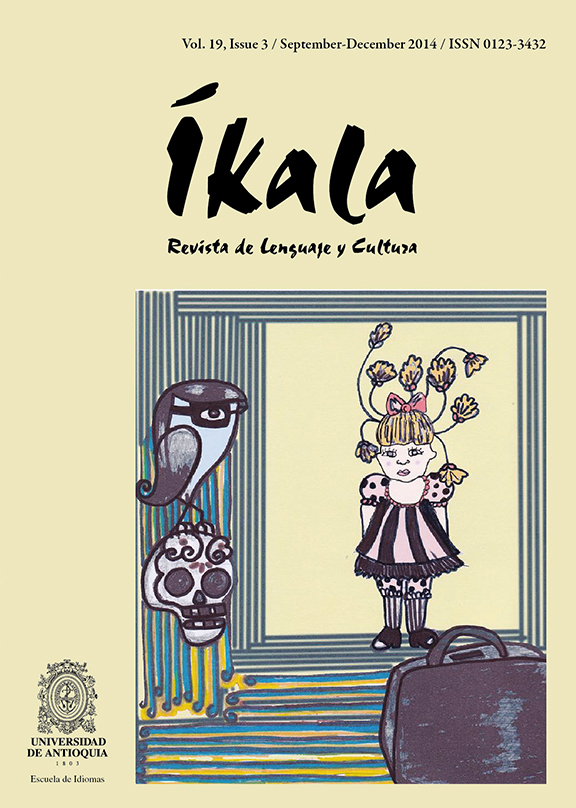Sites de Réseautage Social en Classe: de Nouveaux Rôles pour les Professeurs et de Nouvelles Approches pour Élaborer des Cours
DOI:
https://doi.org/10.17533/udea.ikala.v19n3a04Keywords:
Web 2.0, rôles des professeurs, réseautage social, environnement virtuel dispensé sur le webAbstract
Le Web 2.0 en général et les sites de réseautage social en particulier ont pris une place considérable dans la vie quotidienne. Néanmoins leur introduction en classe n'a pas été étudiée. Cet article présente les résultats issus de l ́utilisation d´un web 2.0, en particulier un site de réseau social qui a servi de support virtuel pour un cours face-à-face. Ces résultats révèlent que la mise en place de cet outil a des effets sur cinq domaines de gestion: (1) gestion des moyens logistiques, (2) gestion des informations et des savoirs, (3) gestion de la communication, (4) gestion du travail de classe dispensé sur le web, et (5) facilité d ́accès à l ́environnement virtuel. Les conclusions de cette étude montrent que l ́utilisation d ́un environnement virtuel dispensé sur le web implique de nouveaux rôles pour les professeurs ainsi que de nouvelles approches pour élaborer des cours en ligne ou des cours hybrides.
Downloads
References
Brown, S. (2012). Seeing web 2.0 in context: A study of academic perceptions. Internet and higher education. 15. 50-57.
Bennett, S., Bishop, A., Dalgarno, B., Waycott, J. &
Kennedy, G., (2012). Implementing web 2.0 technologies in higher education: a collective case study. Computers and Education, 59, 524-534.
Creswell, J. (2007). Qualitative inquiry and research design: Choosing among five approaches (2nd ed.). Thousand Oaks, CA: Sage Publications.
Dwyer, C., Hiltz, S., & Passerini, K. (2007). Trust and privacy concern within social networking sites: A comparison of Facebook and Myspace. In Proceedings of the thirteenth americas conference on information systems. Keystone, Colorado.
Elmaziye, O. & Birikim, O. (2009). Web 2.0 in learning English: the student perspective. Procedia-Social and behavioral sciences, 1(1), 326-330.
Freeman, D. (1998). Doing teacher research: From inquiry to understanding. Boston, MA:Newbury House.
Florez, E., Pineda, J. & Garcia, N (2012). EFL students' perceptions about a web-based English reading comprehension course. PROFILE Issues in Teachers' Professional Development, 14(2), 113-129.
Gonzalez, A & Muñoz, J. (2011). Teaching reading comprehension in English in a distance web-based course: New roles for teachers. PROFILE Issues in Teachers' Professional Development, 12(2), 69-85.
Hemmi, A., Bayne, S., Land, R. (2009). The appropriation and repurposing of social technologies in higher education. Journal of Computer Assisted learning, 25(1), 19-30.
Jeffrey, D., & Hadley, G. (2002). Balancing intuition with insight: Reflective teaching through diary studies. The language teach, 26(5). Retrieved from http://www.jaltpublications.org/tlt/articles/2002/05/jeffrey
Kocak, U., & Guzin, S, (2009). Adoption of web 2.0 in distance education. Procedia. Social and Behavioral Sciences, 1, 818-823.
Lopera, S. & Osorno, J. (2012). Interaction in an EFL reading comprehension distance web-based course. Ikala. Revista de Lenguaje y Cultura, 17(1), 45-59.
Merriam, S. (1998). Qualitative research and case study applications in education. San Francisco, CA: Jossey-Bass.
Pai, P., Arnot, C. (2013). User adoption of social networking sites: eliciting uses and gratifications through and end-means approach. Computers in Human Behavior, 29, 1039-1053.
Pineda, J & Tobón, M. (2011). The use of blogs as learning platforms. ASOCOPI Newsletter, 3, 6-11.
Sanz, S (2005). Comunidades de practica virtuales: Acceso y uso de contenidos. Revista de Universidad y Sociedad de Conocimiento, 2(2), 26-35.
Salmon, G (2011). E-moderating. The key to teaching and learning online third edition. New York. Routledge.
Salmon, G. (2002). E-tivities. The key to active online learning. London. Routledge.
Salmon, G.(2013). E-tivities. The key to active online learning. Second edition. New York. Routledge.
Stake, R. (1995). The art of case study research. Thousand Oaks, CA:Sage.
Wenger, McDermott & Snyder (2002). Cultivating communities of practice: A guide to managing knowledge. Harvard Business School Press. Boston. USA.
Yin, R. (2003). Case study research: Design and methods. Thousand Oaks, CA: Sage Publications
Published
How to Cite
Issue
Section
License
Copyright (c) 2014 Íkala

This work is licensed under a Creative Commons Attribution-NonCommercial-ShareAlike 4.0 International License.












